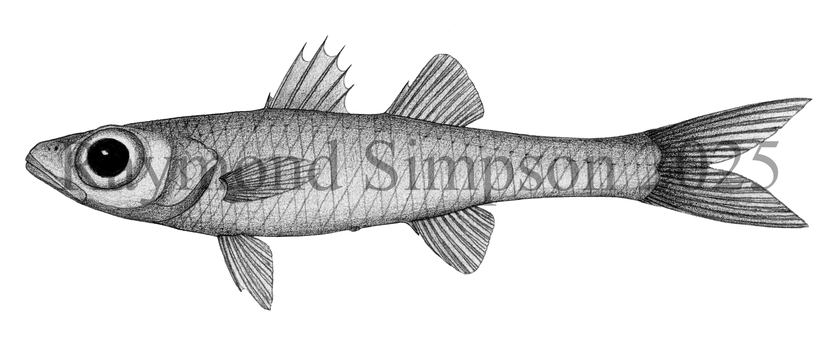
Common Name
Six-spined Cardinalfish
Year Described
Okamoto, Baldwin & Long, 2024
Identification
Dorsal Fin: VI-1, 10
Anal Fin: II, 9
Pectoral Fin: 16-17
Lateral Line: 32-35, plus 3-5 on caudal fin
Gill Rakers: 25-27 (first arch)
Vertebrae: 10+15 = 25 total
Body moderately slender and laterally compressed. Large terminal mouth. Teeth conical. Lingual and endopterygoid teeth present. No enlarged teeth on lower jaw symphysis. Maxillary process absent. Opercular spine absent. Lateral line complete and composed of pored scales. Two scales above and 7 below lateral line at mid-body. 6-7 pyloric caeca. No ribs on abdominal vertebrae. First dorsal spine long. First anal spine tiny. Pectoral fin reaches level of anus. Pelvic fin does not reach anus. Caudal fin forked. Body fully scaled except snout tip and lower jaw. No luminous organ on belly.
Color
Body gray dorsally and silvery white ventrally. Dorsal fin dark. Anal, pelvic and pectoral fins pale. Caudal fin with dark basal area and lobes.
Size
Specimens range from 33-56mm SL.
Habitat
Specimens collected by submersible around 300m, but likely deeper. Found on walls near structure.
Range
Known so far only from Curacao.
References
Mayer, G. F. 1974. A revision of the cardinalfish genus Epigonus (Perciformes, Apogonidae), with descriptions of two new species. Bulletin of the Museum of Comparative Zoology v. 146 (no. 3): 147-203.
Okamoto, M., Baldwin, C. C., & D. J. Long. 2024. Two new species of the deepwater cardinalfish genus Epigonus (Epigonidae) from deep reefs off Curaçao, southern Caribbean. Ichthyological Research, 71(3), 1–10.
Other Notes
Unique in having six dorsal fin spines (other Epigonus have 7-8 spines). The scale count is also useful given it and E. oligolepis are the only species in the area with <40 scales in the lateral series.
Mayer (1974) mentions small specimens assumed to be E. oligolepis from the Gulf of Mexico that have six dorsal spines and 26 gill rakers and toothed tongue. These could actually be E. hexacanthus, or it could be that E. hexacanthus represent juveniles of E. oligolepis that experience significant ontogenetic changes with growth. Genetic data is not available for E. oligolepis to compare but is quite distinct from the species available on BOLD.